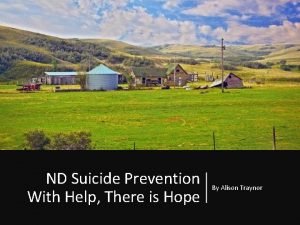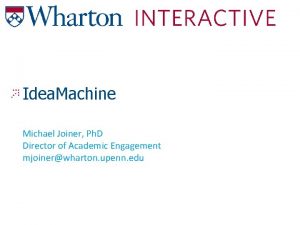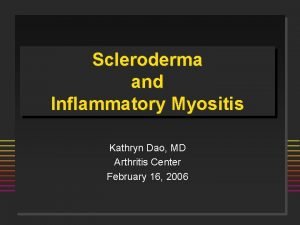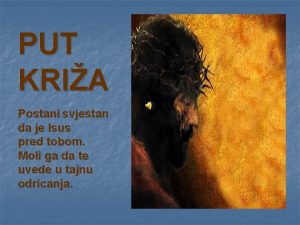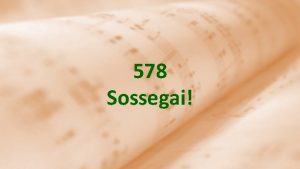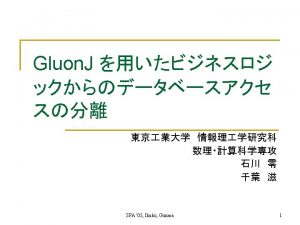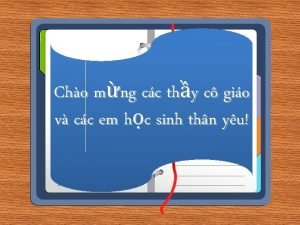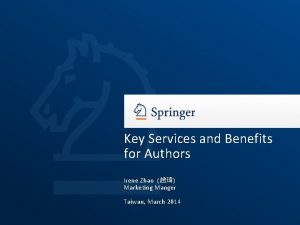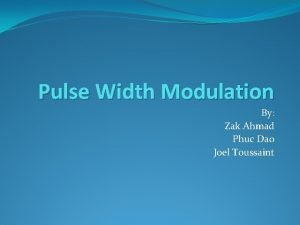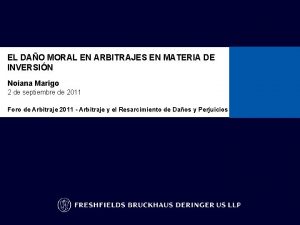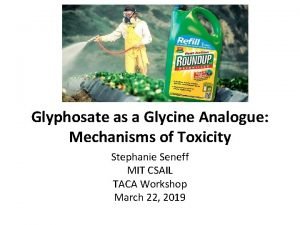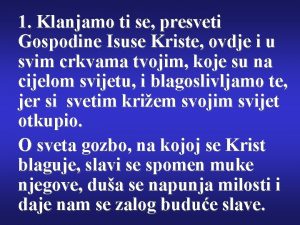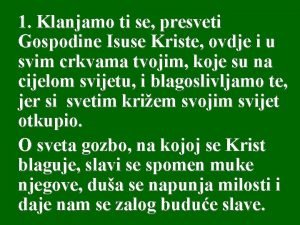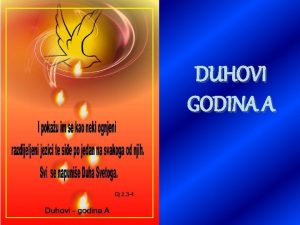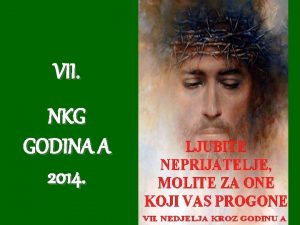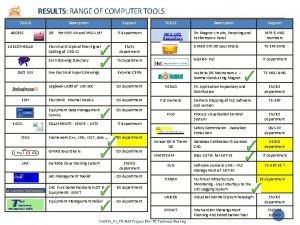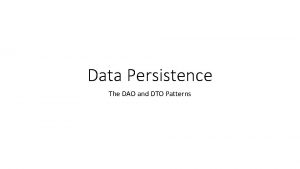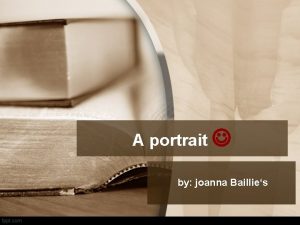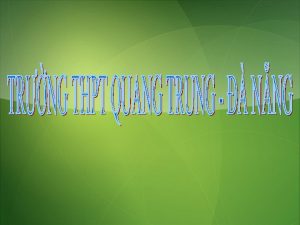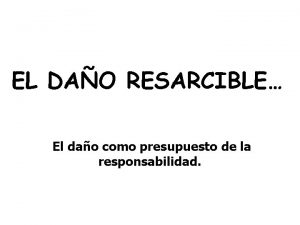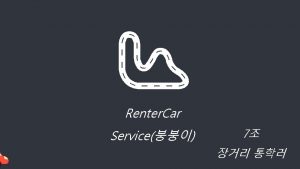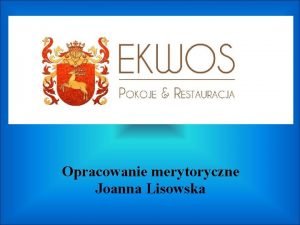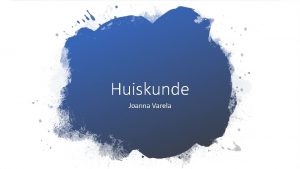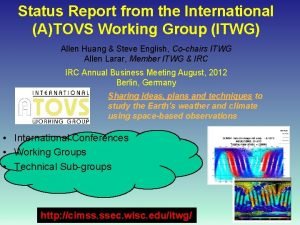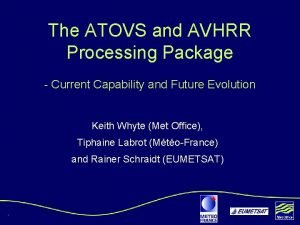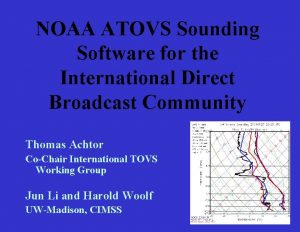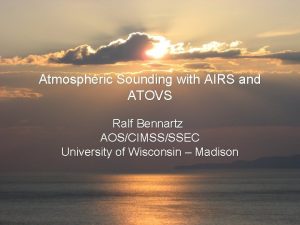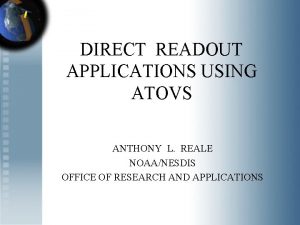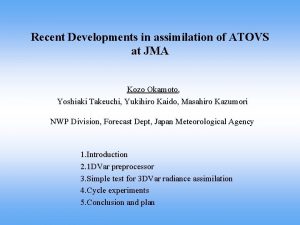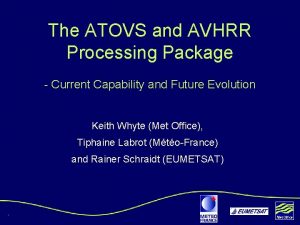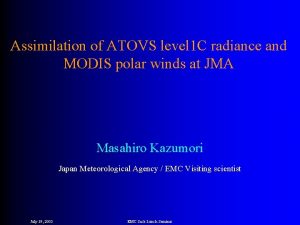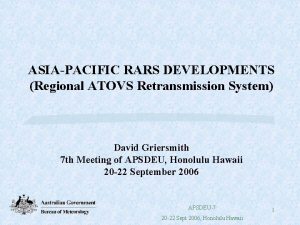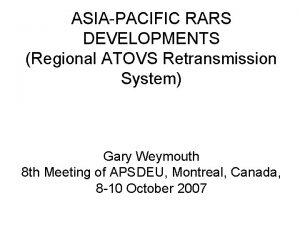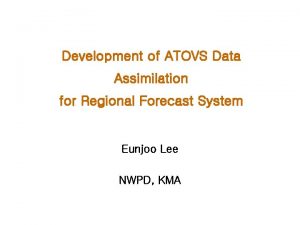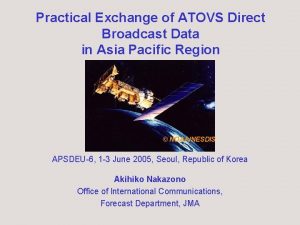Use of ATOVS at DAO Joanna Joiner Donald


























- Slides: 26

Use of ATOVS at DAO Joanna Joiner, Donald Frank, Arlindo da Silva, Emily Liu, Clark Weaver Data Assimilation Office, NASA/GSFC ITSC-12 Joanna Joiner, DAO ITSC-12

Outline 1. 2. 3. 4. 5. Introduction: DAOTOVS 1 DVAR assimilation Assessment of cloud- and land-affected data in DAS Use of OPTRAN OSSE simulations Use of TOVS for land-surface analysis/assimilation • • 6. 7. 8. Off-line skin temperature analysis (including bias correction) Off-line skin temperature assimilation AIRS dynamic channel selection based on cloud height Incorporate effects of aerosol Summary and Future Plans Joanna Joiner, DAO ITSC-12

DAOTOVS attributes • DAOTOVS 1 D-Var Assimilation of Radiances: – – – – Uses Level 1 b data HIRS, MSU, SSU and AMSU-A radiances Variational cloud-clearing (Joiner and Rokke, 2000) Eigenvector FOV determination (AIRS ATBD) Physically-based systematic error correction GLATOVS, MIT -> OPTRAN (JCSDA) Running in operational GEOS-DAS and next-generation Finite-volume DAS (fv. DAS) currently running in parallel Joanna Joiner, DAO ITSC-12

fv. DAS Data Flow (PED coeff) Joanna Joiner, DAO ITSC-12

DAOTOVS: What makes it different? • Uses cloud- and land-affected data (CERES land-emissivity data set based on satellite/laboratory measurements). • Uses all channels except HIRS 16, 17 AMSU 1, 2 (IR bidirectional reflectance, mw emissivity in 1 DVAR state vector) • Variational cloud-clearing (done simultaneously with retrieval); allows for internal quality control, consistency • Tuning using collocated radiosondes (not background). Updated daily via Kalman filter. • Errors in assimilation system include separate components with and without vertical/horizontal correlations Joanna Joiner, DAO ITSC-12

How many cloud formations are seen in NOAA-K data? Answer: ~2 Look at eigenvectors of 3 x 3 array of HIRS pixels R 1 -Rn ~95% of cases explained by two modes (cloudformations) Joanna Joiner, DAO ITSC-12

O-F Statistics NW NE Tropics SW SE • Fit to Rawinsondes • Obs – 6 h Forecast • Bias (spatial RMS, time mean) • Standard Deviations Joanna Joiner, DAO ITSC-12

Cloud clearing has positive impact on 6 hour forecast, verified with radiosondes in finite-volume DAS green: NESDIS TOVS, red: DAOTOVS w/cloudcleared, blue: DAOTOVS, no cloudy Joanna Joiner, DAO ITSC-12

Forecast experiments, RMS error 500 h. Pa height red: cloud-cleared, blue: no cloudy Joanna Joiner, DAO ITSC-12

Impact of land-affected data (red-includes land, blue-no land) Joanna Joiner, DAO ITSC-12

OPTRAN significantly reduces ATOVS radiance biases note: a) scale b) large reduction in channel 1 and 12 biases OPTRAN GLATOVS Joanna Joiner, DAO ITSC-12

Observing System Simulation Experiments (OSSE) • Use fv. CCM/Optran to simulate cloudy radiance • Use GEOSDAS/ GLATOVS for assimilation • Model has reasonable simulation of cloud/upper tropospheric humidity (use maximum overlap assumption) Joanna Joiner, DAO ITSC-12

*The problem: Skin temperature biases over land (especially desert) causing clear-sky Outgoing Longwave Radiation (OLR) biases as compare with CERES; *Problem caused by emissivity used in land-surface model (LSM) and inconsistent definition of ground temperature Joanna Joiner, DAO ITSC-12

Control fv. DAS Ts Bias ECMWF Ts Bias |top|-|mid| Joanna Joiner, DAO ITSC-12

Unbiased Analysis Equation Joanna Joiner, DAO ITSC-12

Ts Bias and Anal. Increments Joanna Joiner, DAO ITSC-12

Joanna Joiner, DAO ITSC-12

New fv. DAS Ts Bias Control fv. DAS Ts Bias |top|-|mid| Joanna Joiner, DAO ITSC-12

More TOVS marked “clear” by internal 1 DVAR QC Red in bottom panel means more TOVS 1 DVAR passes internal cloud checks And determined to be “clear” Joanna Joiner, DAO ITSC-12

Joanna Joiner, DAO ITSC-12

AIRS initial channel selection Joanna Joiner, DAO ITSC-12

Channel selection based on retrieved cloud height Cloud: 50% at 200 h. Pa Yellow: Clear. Cloudy Green: Add noise, background errors 17 channels unaffected by cloud Joanna Joiner, DAO ITSC-12

Channel selection based on retrieved cloud height Cloud: 10% at 700 h. Pa Yellow: Clear. Cloudy Green: Add noise, background errors 77 channels unaffected by cloud (If retrieve pressure of 525, get 58 channels) Joanna Joiner, DAO ITSC-12

Using model-simulated aerosol in DAOTOVS (Weaver poster) Top: O-F HIRS 8 no dust in calculations Bottom: O-F HIRS 8 dust from transport model included in radiative transfer Joanna Joiner, DAO ITSC-12

Summary and Future Work • Cloud- and land-affected data has positive impact on forecasts (6 hrs-5 days) • OPTRAN reduces biases, but little overall impact due to tuning • OSSE simulations show reasonable model cloud • TOVS Ts analysis (including bias correction) improves OLR, clearscene identification over land • AIRS channel selection good for cloudy situations (sharp weighting functions); Dynamic channel selection in cloudy scenes, cloud slicing-like approaches worthwhile • Aerosol effects are significant (see Weaver poster) Joanna Joiner, DAO ITSC-12

In the future… • GOES sounder (JCSDA) • AMSU-B • Analyze pseudo-relative humidity instead of ln(q) in 1 DVAR • Partial eigen-value decomposition/radiance assimilation • AIRS – more from Don Frank Joanna Joiner, DAO ITSC-12
 Joanna joiner
Joanna joiner Sources of strength wheel
Sources of strength wheel Thomas joiner suicide
Thomas joiner suicide Why people die by suicide joiner
Why people die by suicide joiner Michael joiner upenn
Michael joiner upenn Scleroderma
Scleroderma Tko je isusu dao rubac
Tko je isusu dao rubac O mestre o mar se revolta
O mestre o mar se revolta Dao as a service
Dao as a service Các kiểu liệt kê
Các kiểu liệt kê Decentralized autonomous organization (dao)
Decentralized autonomous organization (dao) Irene zhao dao
Irene zhao dao What is duty cycle
What is duty cycle Dao moral
Dao moral Dao deficiency
Dao deficiency Hosana u visini tekst
Hosana u visini tekst Nipeide
Nipeide Lateranska bazilika
Lateranska bazilika Pashalna noć
Pashalna noć Có công mài sắt có ngày nên kim
Có công mài sắt có ngày nên kim Ti dao si nam čvrstu riječ
Ti dao si nam čvrstu riječ Dao dang
Dao dang Hostijo bijela tekst
Hostijo bijela tekst Zhao yuqi
Zhao yuqi Ti dao si nam čvrstu riječ
Ti dao si nam čvrstu riječ Qps jira
Qps jira Dto in java
Dto in java

